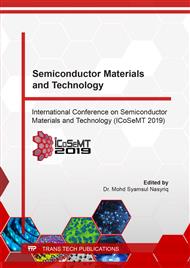[1]
J. Tavakoli, Y. Tang, Hydrogel based sensors for biomedical applications: an updated review, Polymers, 9 (2017) 364.
DOI: 10.3390/polym9080364
Google Scholar
[2]
R.L. Rich, G.A. Papalia, P.J. Flynn, J. Furneisen, J. Quinn, J.S. Klein, et al., A global benchmark study using affinity-based biosensors, Anal. Biochem., 386.2 (2009) 194-216.
Google Scholar
[3]
M. Zourob, S. Mohr, B.J.T. Brown, P.R. Fielden, M.B. McDonnell, N.J. Goddard, An integrated metal clad leaky waveguide sensor for detection of bacteria, Anal. Chem., 77 (2005) 232-42.
DOI: 10.1021/ac049627g
Google Scholar
[4]
R. Gupta, B. Bastani, N.J. Goddard, B. Grieve, Absorption spectroscopy in microfluidic flow cells using a metal clad leaky waveguide device with a porous gel waveguide layer, Analyst, 138 (2013) 307-14.
DOI: 10.1039/c2an35898k
Google Scholar
[5]
M. Zourob, N.J. Goddard, Metal clad leaky waveguides for chemical and biosensing applications, Biosens Bioelectron, 20 (2005) 1718-27.
DOI: 10.1016/j.bios.2004.06.031
Google Scholar
[6]
M. Zourob, S. Mohr, B.J.T. Brown, P.R. Fielden, M. McDonnell, N.J. Goddard, The development of a metal clad leaky waveguide sensor for the detection of particles, Sensor Actuat B-Chem, 90 (2003) 296-307.
DOI: 10.1016/s0925-4005(03)00052-2
Google Scholar
[7]
Y. Miao, K. Zhang, Y. Yuam, B. Liu, H. Zhang, Y. Liu, et al., Agarose gel-coated LPG based on two sensing mechanisms for relative humidity measurement, Appl. Opt., 52 (2013) 90-5.
DOI: 10.1364/ao.52.000090
Google Scholar
[8]
Z. Cao, R.J. Gilbert, W. He, Simple Agarose − Chitosan gel composite system for enhanced neuronal growth in three dimensions, Biomacromolecules, 10 (2009) 2954-9.
DOI: 10.1021/bm900670n
Google Scholar
[9]
F.J. Arregui, Z. Ciaurriz, M. Oneca, I.R. Matıas, An experimental study about hydrogels for the fabrication of optical fiber humidity sensors, Sensor Actuat B-Chem, 96 (2003) 165-72.
DOI: 10.1016/s0925-4005(03)00520-3
Google Scholar
[10]
K.J. Lee, D. Wawro, P.S. Priambodo, R. Magnusson, Agarose-gel based guided-mode resonance humidity sensor, IEEE Sens. J., 7 (2007) 409-14.
DOI: 10.1109/jsen.2006.890129
Google Scholar
[11]
A. Jain, A.H. Yang, D. Erickson, Gel-based optical waveguides with live cell encapsulation and integrated microfluidics, Opt. Lett., 37 (2012) 1472-4.
DOI: 10.1364/ol.37.001472
Google Scholar
[12]
A.K. Agarwal, S. Singla, A. Kumar, Hypokalemic Paralysis: Emergency Room Management, in: A.K. Agarwal (Ed), Medicine Update, Noida, Association of Physicians of India, 2009, p.42–9.
Google Scholar
[13]
S. Ladet, L. David, A. Domard, Multi-membrane hydrogels, Nature, 452 (2008) 76-79.
DOI: 10.1038/nature06619
Google Scholar
[14]
M. Dash, F. Chiellini, R.M. Ottenbrite, E. Chiellini, Chitosan: A versatile semi-synthetic polymer in biomedical applications, Prog. Polym. Sci., 36 (2011) 981-1014.
DOI: 10.1016/j.progpolymsci.2011.02.001
Google Scholar
[15]
H. Yi, L.Q. Wu, W.E. Bentley, R. Ghodssi, G.W. Rubloff, J.N. Culver, et al., Biofabrication with Chitosan, Biomacromolecules, 6 (2005) 2881-94.
DOI: 10.1021/bm050410l
Google Scholar
[16]
S.R. Makhsin, P. Gardner, N.J. Goddard, P.J. Scully, Surface modification of titanium-coated glass substrate embedded acrylate-based hydrogel film for optical metal clad leaky waveguide (MCLW) biosensors, 2017 IEEE SENSORS, (2017) 1-3.
DOI: 10.1109/icsens.2017.8234289
Google Scholar
[17]
S.K. Shukla, A.K. Mishra, O.A. Arotiba, B.B. Mamba, Chitosan-based nanomaterials: A state-of-the-art review, Int. J. Biol. Macromol., 59(2013) 46-58.
DOI: 10.1016/j.ijbiomac.2013.04.043
Google Scholar
[18]
G.T. Hermanson, PEGylation and Synthetic Polymer Modification, Bioconjugate techniques, Academic press, 2013, pp.787-838.
DOI: 10.1016/b978-0-12-382239-0.00018-2
Google Scholar


